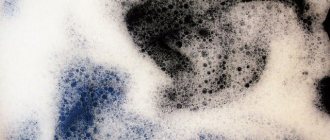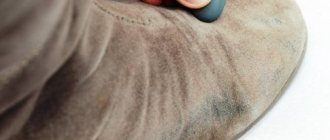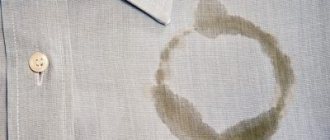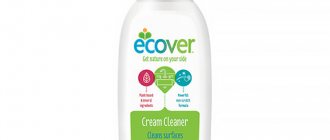The problem of effectively removing oil stains from fabric is always relevant. Even a small drop of oil that gets on your clothes while cooking or eating food can ruin the appearance of your clothes. Removing grease stains requires a lot of time and effort, but does not always bring the desired result. This happens when cleaning clothes does not follow all the rules that need to be followed to successfully complete the process. There are several proven ways to remove oil from clothes quickly and without compromising its quality.
Is it possible to get rid of oil stains?
A special feature of the oil is its ability to be absorbed into any tissue almost immediately after contact. However, removing shiny oil marks is a completely doable task. In order to clean clothes without leaving any marks on them and without wasting time, you need to do it competently and know a few important rules:
- Choose the right oil remover according to the type and structure of the fabric.
- Try to remove the stain as quickly as possible after it appears. The sooner you start treating the stain after it appears, the greater the chance of success. Fresh stains are cleaned much easier and faster than old ones.
- First, blot the stain with a paper towel, which will absorb a significant portion of the grease.
- Remove dust and dirt from the stain using a soft-bristled toothbrush.
- After applying the appropriate product to the stain, you need to begin removing the fat. This should be done delicately, with smooth, careful movements, from the edges to the center, without rubbing, so that the oil is not absorbed even deeper.
- Heated oil is removed faster, so the area covered with paper can be ironed with a hot iron.
- After using cleaning products, you need to wash the soiled item (if its label contains information about the permissibility of wet processing). When washing, you can add 1 tablespoon of vinegar to the water. If the instructions allow, it is better to use hot water when machine washing; it will help remove greasy stains faster.
- You can dry it only if the stain is completely removed, otherwise it will stick even more firmly to the clothes. The product should be dried strictly in accordance with the instructions.
Urgent measures for fresh stains
The sooner you start removing grease stains from jeans at home, the higher the chances of success.
If the liquid manages to penetrate deep into the fibers of the fabric or forms a sticky layer on the surface, it will be difficult to remove it without a trace. Fresh stains can be removed using an iron and clean napkins, toothpaste, dishwashing gel, mustard powder, starch and other available products.
Regardless of the cleaning agent used, do not rub your jeans too hard. This will cause the oil trail to spread and the stain will only increase in size. Rubbing is carried out from the edges to the center. For the same reason, you should not immediately wash oily clothes.
Napkin + iron
Regular napkins will help remove a greasy stain or most of it from jeans.
They are applied to the fabric and wait for them to absorb the oil. As soon as the napkin becomes greasy, it is replaced with a new one. The effectiveness of the method increases the use of the iron by an order of magnitude.
Instructions for cleaning jeans:
- lay the fabric on a flat surface;
- attach a clean napkin or kitchen towel;
- walk the iron over the prepared area;
- change the napkin to a clean one and repeat the procedure.
It is prohibited to use colored napkins to remove grease stains. Exposure to high temperatures can stain clothing.
When cleaning jeans with an iron, you will have to protect the ironing board from getting oil stains. The ideal option is to cover it with foil. It will create a barrier for fat, plus it will increase the heating of the tissue.
Toothpaste
Toothpaste will help remove grease stains on jeans.
The only limitation is that it should not contain bleaching components that are potentially harmful to the color.
Instructions for cleaning jeans:
- squeeze the paste from the tube onto the stain;
- distribute the product evenly over the problem area;
- leave for 30 minutes;
- rinse off any remaining paste;
- reapply the product, scrub the stain with a toothbrush;
- machine wash your jeans.
Tooth powder will get rid of oil traces. It will have to be first diluted with water to a thick paste.
Dishwashing liquid
Substances contained in all dishwashing detergents effectively dissolve grease.
This property is used to remove fresh greasy stains from fabrics.
Instructions for cleaning jeans:
- drop detergent onto the greasy stain;
- lightly rub the gel until foam forms;
- leave for 10–15 minutes;
- add dishwashing detergent along with washing powder into the appropriate compartment of the machine;
- Wash the jeans at the maximum temperature allowed by the manufacturer.
The detergent will help remove traces of grease. However, you can remove a stain from vegetable oil only if it has not had time to dry.
Powdered mustard
Mustard powder absorbs fat even better than salt.
Fine grinding causes capillary tension between the crystals, resulting in oil absorption.
Instructions for cleaning jeans:
- pour mustard powder into the container;
- add warm water so that you get a thick paste;
- Spread the mixture onto the jeans with a spoon (without rubbing into the fabric);
- leave for half an hour and rinse with water.
Finally, the clothes are machine washed. However, this can be done if the stain has been cleaned. Otherwise, you will have to try more radical removal methods.
Starch
Starch has sorbing properties similar to mustard.
Any type of powder (potato, corn, etc.) is suitable for cleaning.
Instructions for cleaning jeans:
- from starch and a small amount of water, prepare a mixture whose consistency resembles liquid sour cream;
- soak a cotton pad in the starch solution and apply it to the stain in a thick layer;
- leave the item until the liquid dries;
- machine wash with regular detergent.
For the cleaning method to work, do not use too hot water for washing. Because of it, the starch will begin to thicken and lose its ability to absorb oils.
Homemade cleaners such as citric acid, soda or chalk should be used with caution on jeans. They are capable of discoloring the surfaces to which they were applied. Because of this, it is better to use them on light-colored items or test them first on an inconspicuous area.
First aid supplies
Before washing, a greasy stain on the fabric must be pre-treated with a suitable product. There are many ways to remove vegetable oil stains using a wide variety of compounds and substances. It is necessary to choose from them exactly those that are suitable specifically for this type of fabric.
Using household chemicals
Reliable helpers in the fight against oil stains are chemical cleaning products used in everyday life.
- Dish gel, which contains substances that break down fat. To remove stains, just take a small amount of this product. It should be applied to the stain and left for a few minutes before washing. Instead of gel, you can use shampoo or shaving foam in the same way.
- Detergents for plumbing. Sprinkle a small amount of this powder on the stain, pour a small amount of water on top and leave for 20-25 minutes. Then you should rinse the item and wash it. This method is used only for light-colored dense fabrics, as it contains chlorine, which discolors the product.
- Bleach. This substance is used only for white clothes.
- Special products for removing stains. Home improvement stores have a large selection of stain removers that can quickly and easily remove vegetable oil stains, but they are not suitable for every fabric. These products must be used in accordance with the instructions. It is recommended to pour the composition applied to a greasy area of clothing with hot water, which perfectly breaks down the fat.
How to remove old stains
The fight against old stains is more difficult, since the fat has already been absorbed and ingrained into the fibers. Now it is more difficult to remove dirt. White vinegar is suitable for this. Dampen a napkin or cloth with vinegar and blot away the dirt. Wait 20-30 minutes and then wash the clothes.
Purified gasoline quickly and effectively removes stains and copes even with difficult and old stains. Instead of gasoline, you can also take kerosene or grease. Apply a few drops of the product to the oily area and rinse with water after ten minutes.
Turpentine is an effective and aggressive agent. To clean clothes, soak a cotton pad in the mixture and apply to the contaminated area of the fabric. Once the turpentine is absorbed, wash your jeans. In addition, you can prepare a special solution.
Mix equal parts alcohol and turpentine, add a little shavings of laundry soap. Apply the resulting mixture to the stain and wipe the fabric. Leave for ten minutes and wash clothes as usual. We looked at how to remove vegetable oil and grease from jeans. Read here how to remove stains from Coca-Cola and other drinks.
Folk remedies
The problem of soiled clothes can be successfully solved by simple, reliable and proven means:
- Refined gasoline, kerosene or acetone. These substances can remove even old, deeply ingrained stains. Before use, it is recommended to test them by applying a small amount to an inconspicuous area of clothing to check whether they affect the color of the fabric. These products can not only discolor, but also damage the structure of the material being processed, so they should be used carefully. They are typically used to clean jeans and other thick fabrics. You need to moisten a cotton swab with one of these products and apply it to the contaminated area, and pour water on top. Processing must be carried out in a well-ventilated area where there are no sources of open flame. After this, you should iron the stain with a warm iron, after covering it with a sheet of paper, then wash it in a moderate mode or by hand. It is recommended to use these products with gloves. A mixture of gasoline and flour in a 1:2 ratio cleans stains well.
- A solution of turpentine, ammonia and grated laundry soap. This homemade stain remover is also only suitable for items not made from delicate fabrics. The greasy stain is poured with the resulting mixture and left for 20 minutes (if the stain is old - approximately 1.5 hours). Then you should rinse the clothes in cold water and put them in the wash. By the way, ammonia, which copes well with any contaminants, can also be used in combination with water and washing powder (100 ml of water and one teaspoon each of alcohol and powder).
- Table salt is one of the simplest and most well-known universal remedies for removing fresh stains. After sprinkling the oily area of the fabric with salt, you need to wait until all the fat is absorbed, after which the stain can be easily removed by washing. Note! To speed up the process, place the item on a flat surface, and place a clean cotton napkin or towel on top of the salt, then iron it at medium temperature. If necessary, repeat the procedure, adding the required amount of salt each time.
- Excellent for removing fresh stains and tooth powder. This product is left on the stain until it turns yellow (this means that the grease has been absorbed).
- Starch. The oil stain is sprinkled with this product in large quantities and ironed through a soft cloth, after which it is left for 2-3 hours. If there is a large stain, change the starch and repeat the procedure.
- Baking soda perfectly absorbs grease and odors. To remove a stain, blot it with a paper towel and sprinkle with a thick layer of baking soda. After about an hour, remove it with a wet sponge and wash the clothes. If this remedy does not help, you can additionally use hydrogen peroxide. It is applied to the contaminated area of the fabric, a thick layer of soda is poured on top, and dishwashing detergent is applied to the whole thing. This composition should remain on clothing for 30-60 minutes.
- Dry mustard. Mustard powder should be diluted in a small amount of warm water to a paste. The resulting composition must be applied to the stain and wait until the mixture dries completely. After this, you should brush the stain, rinse with water and wash the clothes. This product is not recommended for use on light-colored items.
- Talc. Powder, which has high absorbent properties, poured onto the stain, is covered with paper, ironed and left for 4-5 hours. It is advisable to put some weight on top.
- Chalk works best to remove stains from cotton, silk and linen. It should be crushed into powder, poured onto the stain, and after 2 hours removed with a wet sponge.
- Laundry or tar soap. It should be rubbed, applied to the stain and left for 2 hours before washing.
- Hairspray is also a good way to remove grease stains. It is sprayed onto the contaminated area, covered with a paper towel, and after half an hour the item is sent to the wash.
- Glycerin is used primarily for cleaning white clothes. 2-3 drops are enough to remove even an old stain. Remove the product with a clean cotton swab.
Eliminating fresh contamination
It is advisable to start dealing with the stain immediately after it appears. Gently blot the stain on your clothing with a paper towel. This will remove some of the fat without giving it time to penetrate deeper into the tissue. Important: do not rub the stain, otherwise the oil will be absorbed even more into the fabric fibers.
You can completely remove a fresh stain from sunflower, olive and other types of vegetable oils using the following available means.
Salt
The most famous, fastest and most affordable way. Salt is sprinkled onto the contaminated area, rubbed into the stains and left for a while, then shaken off. Repeat the entire process as many times as possible until the stain disappears completely.
Tooth or chalk powder
Sprinkle crushed chalk or teeth cleaning powder on top of the vegetable oil mark. The substance is carefully rubbed into the oil stains and left for 2 hours so that it absorbs all the fat. After this time, the mass that has absorbed the fat is brushed off. White traces of powder or chalk are washed off with warm water.
Mustard
Sprinkle mustard powder onto the stained area for 2 minutes, then shake off. Soap the same stain using laundry soap, rub with a sponge or brush, and rinse under running warm water. Repeat all steps until the oily trace disappears completely.
Dish cleaner
Place a small amount of product on the oil stain, rub gently, and put the clothes in the washing machine.
Ironing
Thermal effects will help deal with fat stains. To do this, place paper towels on both sides, bottom and top, of the stained area. The iron is heated to medium temperature and the fabric begins to iron. At this time, the fat will melt and begin to be absorbed into the paper. The entire cleaning process is repeated several times during operation, replacing the napkins with new ones.
Features of cleaning different fabrics
Any grease remover should be selected depending on the structure of the fabric from which the clothing is made.
We recommend:
How to wash pants
Important! Aggressive cleaning agents (gasoline, acetone and others) are not suitable for wool, silk and some types of synthetics. Using them to clean delicate fabrics can discolor the product and distort the fibers. These substances are used only for durable fabrics with a dense structure. It is recommended to treat stains on such clothes on both sides at once.
Denim pants and a jacket, which quickly absorb any oil, can be peeled with raw potatoes.
A solution of salt and alcohol (1:3) is also used. After rubbing the mixture into the stain, wait 10-15 minutes until it is completely absorbed and rinse the item with cool water.
Fat is removed from delicate fabrics using salt, chalk, starch and other available means. Ammonia in combination with warm water also helps (1 teaspoon of alcohol is diluted in 250 ml of water). A cotton swab is moistened in this solution and the stain is wiped, after which a cotton cloth is placed on it and smoothed.
Removing an oil stain from jeans
Jeans can rightfully be called the most comfortable, all-season and all-age clothing. And therefore, the question of proper and effective cleaning of various stains and dirt on them is of interest to many. Grease or oil stains form more often than others. How to remove an oil stain on jeans from sunflower or machine or motor oil, depending on its freshness, we’ll try to figure it out in this article.
After using any of these methods, please note that after treatment with the product, you should first wash the stained area, and then wash the jeans completely. And you can understand whether the stain has gone away or not only after drying, since it will be difficult to understand when wet.
Removing oil stains of various origins from clothes
To effectively cleanse fabrics of greasy stains, it is important to know how to wash different types of vegetable oil.
Sea buckthorn oil
It leaves behind deep-absorbing yellow greasy stains, which take a long time to remove and require special attention. It is impossible to remove such contamination without preliminary preparation. The following tools best cope with this task:
- dishwashing liquid;
- laundry soap (especially for cotton and wool);
- toothpaste for light-colored clothes;
- bleaches and stain removers for old stains;
- a mixture of potato starch and turpentine;
- acetone;
- starch (removes only fresh stains);
- vinegar in equal proportions with water;
- ammonia for light-colored clothes.
Sunflower and olive oils
You can remove sunflower and olive oils from clothes using home remedies: salt, rolled bread crumb, starch, acetone, or a mixture of liquid soap and gasoline, taken in equal proportions.
Vaseline oil
This substance has a dense structure and the ability to be instantly absorbed into the fabric. It can be cleaned using:
- chalk or tooth powder;
- dishwashing liquid;
- stain remover;
- a mixture of gasoline and talc (after the gasoline has evaporated, use the blunt side of a knife to carefully scrape off the talc and wipe with a dry cloth);
- a method of cleaning by boiling a product with soda and washing powder.
Methods for removing fresh stains
You can get dirty while cooking, when hot oil splashes, or simply while eating food. How to remove oil stains from fresh clothes? Don't delay, start washing soon. Start cleaning the item right away - you will have to use less chemicals.
Frustrated person pointing to spilled curry stain on white shirt
Salt
How to remove oil from clothes using salt? The flaw in the clothing must be generously sprinkled with salt and pressed into the fabric. Leave the item in a horizontal position, not in the open sun, for up to 40 minutes, shake off the salt.
It is worth checking whether there is any fat left; if so, then repeat the procedure.
Laundry soap
To neutralize oil stains, cover the dirty area with foam. There should be a lot of foam so that the air bubbles completely fill the stain. Let the item soak in soap for about half an hour.
You can soak it in a bowl of warm water and leave it overnight. Rinse in fresh, warm water. Soap should be without obsessive odors.
Chalk, tooth powder or talc
How to remove an oil stain with bulk cleaning ingredients? All of them belong to powder absorbents. Apply and rub with a sponge or toothbrush. Rough pressure can damage the fabric.
After a few hours, the remaining absorbent should be shaken out over the bathtub.
Dish detergent
Do you know how to remove sunflower oil from clothes using detergents? Kitchen products will wash not only dirty dishes, but also clothes. It is necessary to make a solution in warm water with the addition of detergent. Soak the item in this water for a few minutes and wash it.
Can be repeated without pre-drying. To do this, you should use detergents for dishes, and not for ovens or grills, because they contain chemicals that can damage the fabric and the appearance of the product as a whole.
Bleach
Are your white clothes dirty? Then let's get to the bleach. There is a choice - gels, solutions, pencils. In any form, their effect will be the same.
Oily areas should be moistened with warm water and only then treated with bleach, which should be rubbed in with a sponge. Let the item “acidify” for half an hour, then wash the item in soapy water. Choose oxygen bleaches.
Ammonia and turpentine
These components should be used together with warm water. It is worth emphasizing that the entire thing cannot be soaked in the solution. You just need to moisten a cotton pad and use it to treat the contaminated area. Place a piece of cotton fabric on top of the treated area and iron it with hot steam. Wear gloves to avoid damaging the skin of your hands. Also open windows to ventilate the room.
Starch
How to wash vegetable oil with potato starch? The action of starch is to draw out remaining fat; it works in symbiosis with the washing machine. Pour starch onto the inside of the dirty item and rub it in. After 15-20 minutes, remove the remaining starch and soak the item in soapy water. When the item is in the solution, you can gently wring it out and put it in the washing machine. If you do not remove the starch, the item may become rough.
The iron itself is not so great at dealing with greasy stains, but then how can you remove the stains? Thanks to steam and elevated temperature, the fluidity of the oil increases and it disappears from things. Thick paper is placed on the affected item, and a heated iron is placed on top. When the paper has absorbed oil, change it and continue doing this until it is clean.
Baking soda
Baking soda itself is an alkali that both absorbs and breaks down grease stains. Dry baking soda must be rubbed into the stain. Clean it off after half an hour. If necessary, the procedure can be repeated several times. It is better to use a sponge for rubbing.
Soap and washing powder
First, the area around the contamination must be moistened with warm water. Next, take a barely damp brush and rub the stained area with grated soap or powder. After this manipulation, wet the center to be rubbed with a damp cloth or cloth. Do this until the napkin stops taking on greasy stains. After this, you can use the washing machine.
Glycerin with ammonia
Glycerin is mixed with ammonia, with the addition of a soap solution. The liquid is applied to the fabric. After 30 minutes, wash the item in the washing machine. If it is a large item, then it is washed by hand. It is recommended to work with gloves and a mask.
Mistakes to Avoid
In order not to harm the product by inept cleaning, you need to remember that when removing greasy stains you cannot:
- try to wash the fabric without first treating the contaminated area;
- use products that are not suitable for this type of fabric;
- use too hard brushes;
- dry the product in a machine without ensuring that the stain has been completely removed;
- Use colored cleaning products: dyes can damage the fabric being treated.
The problem of cleaning clothes from oil stains can be dealt with using an arsenal of numerous folk methods and household chemicals. By choosing from them those that are most suitable for a particular fabric, you can get rid of both fresh and stubborn dirt. If you still haven’t been able to remove the unattractive grease stain, you shouldn’t give up and say goodbye to your favorite item: in this case, you can resort to dry cleaning services.
How to remove an oil stain: recommendations
To ensure maximum efficiency when washing items with greasy stains, you should follow simple rules:
- Dried greasy stains on a jacket or other item are very difficult to remove, so it is better not to delay their removal.
- Having chosen a method for getting rid of a greasy stain, you should test the reaction of the fabric on a small area and then remove the stain. Some substances can damage the structure of the fabric.
- It is preferable to wash things after treatment with special means first by hand, and only then in a washing machine. Some items, such as suede jackets, are not machine washable.
- It is better to remove the stain with a brush or cotton swab, without rubbing it further, so as not to damage the fabric structure. This is especially true for clothes and shoes made of suede.
- Items made from expensive fabrics, such as suede, are best dry cleaned.
- Thick fabrics should be processed from the wrong side.
- You can deal with stains on white fabric using bleach.
- Gasoline and other solvents are best used for thick fabrics of jackets or other outerwear, while removal from light textures should be carried out using more gentle means.
By following these recommendations, you can get rid of stains on clothes and keep your favorite item.











